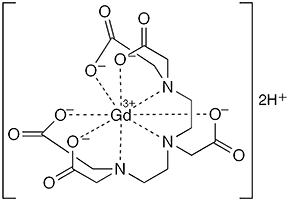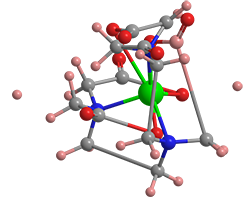What molecule am I?


Gadopentetic acid is a gadolinium(III) complex used as a contrast agent in magnetic resonance imaging (MRI). The Gd3+ cation is complexed with the trianion of pentetic acid1, also known as diethylenetriaminepentaacetic acid (DPTA).
The earliest appearance of gadopentetic acid in the chemical literature came in 1982, when Thomas J. Wenzel, Martin E. Ashley, and Robert E. Sievers* at the University of Colorado (Boulder) reported that several complexes of metal ions with polyanions could be used as water-soluble paramagnetic relaxation agents for 13carbon NMR spectroscopy. They found that iron(III)– and chromium(III)–DPTA complexes were especially suited for facilitating spin relaxation; but that the gadolinium complex caused severe broadening of the carbon resonances near the complexation site because the Gd3+ ion bonds with other electron donors present.
Two years later, H. Gries and H. Miklautz at the Free University of Berlin disclosed that the physiochemical properties of gadopentetic acid make it a good MRI contrast agent. In the ensuing years, other gadolinium-based contrast agents were investigated, including one described in 1997 by J. Platzek and co-workers at Schering (Berlin) in which Gd3+ is complexed with a much larger chelating agent called DO3A-butrol.
The use of gadopentetic acid in MRI has been routine since the 1990s. But in recent years, concerns arose that, despite the strength of the complex, it could break apart and enter other organs, including the brain. In February 2023, Joshua DeAguero, Brent Wagner, and collaborators at the University of New Mexico (Albuquerque) and other institutions reported that some patients who had MRI scans developed gadolinium nanoparticles in the kidneys, leading to nephrogenic systemic fibrosis, a painful disease that affects the skin and organs and is often fatal. Experiments in laboratory animals confirmed this effect.
Gadolinium in the kidneys also has environmental implications. The toxic metal has been found in higher-than-normal levels in the San Francisco Bay and in tap water in New Mexico and Germany, according to the authors. Despite statements in safety data sheets that gadopentetic acid is “not a hazardous substance or mixture”, it can indeed cause considerable damage.
1. CAS Reg. No. 67-43-6.
Gadopentetic acid hazard information
| Hazard class* | GHS code and hazard statement |
|---|---|
Not a hazardous substance or mixture |
*Globally Harmonized System (GHS) of Classification and Labeling of Chemicals.
Molecules in the News
This week’s news brings new hope for overcoming antibiotic-resistant bacteria.—Ed.
Zosurabalpin1 is a developmental antibiotic aimed specifically at carbapenem2-resistant strains of Acinetobacter baumannii (CRAB), an often-deadly pathogen. The drug candidate, a macrocyclic peptide, is being developed jointly by researchers at Hoffmann-La Roche (Basel, Switzerland) and Harvard University (Cambridge, MA).
Zosurabalpin is one of a new class of antibiotics that blocks the transport of toxic lipopolysaccharides from the inner bacterial membrane to the outer membrane. In January, the researchers reported that zosurabalpin effectively controls highly drug-resistant isolates of CRAB in vitro and in mouse models of infection. The molecule is effective because, unlike other antibiotics, it penetrates the outer bacterial membrane.
Cresomycin3 is another antibiotic under development to overcome bacteria that have mutated to strains that resist existing drugs. Last month, Yury S. Polikanov, Andrew G. Meyers, and colleagues at the University of Illinois at Chicago and Harvard University described the design, synthesis, and microbiological evaluation of this bridged macrobicyclic compound, which is related to the lincosamide class of antibiotics.
Cresomycin is designed to bind tightly to bacterial ribosomes; this property avoids the mechanism that resistant bacteria use to evade other antibiotics. The new drug is efficacious against Gram-positive and Gram-negative bacteria, including multidrug-resistant strains of Staphylococcus aureus, Escherichia coli, and Pseudomonas aeruginosa. A 2023 patent application, WO/2023/205206, covers cresomycin and other lincosamides.
1. CAS Reg. No. 2379336-76-0.
2. Carbapenems are antibiotics that are often effective against multidrug-resistant bacteria.
3. CAS Reg. No. 2999743-51-8.
Molecules in the News
MOTW highlights molecules that appear in major news outlets. See this week's edition below.
This molecule was suggested by a reader. We present almost all of the molecules suggested by our readers. If you have a molecule you would like us to consider, please send us a message. And thank you for your interest in Molecule of the Week! —Ed.
Gadopentetic acid fast facts
| CAS Reg. No. | 80529-93-7 |
| CA Index Name | Gadolinate(2–), [N,N-bis[2-[bis[(carboxy-κO)methyl]amino-κN]ethyl]glycinato(5–)-κN,κO]-, hydrogen (1:2) |
| Empirical formula | C14H20GdN3O10 |
| Molar mass | 547.58 g/mol |
| Appearance | White powder |
| Melting point | 129 °C (dec.) |
| Water solubility | 100 g/L |

Learn more about this molecule from CAS, the most authoritative and comprehensive source for chemical information.
Molecule of the Week needs your suggestions!
If your favorite molecule is not in our archive, please send us a message. The molecule can be notable for its current or historical importance or for any quirky reason. Thank you!
Stay Ahead of the Chemistry Curve
Learn how ACS can help you stay ahead in the world of chemistry.

